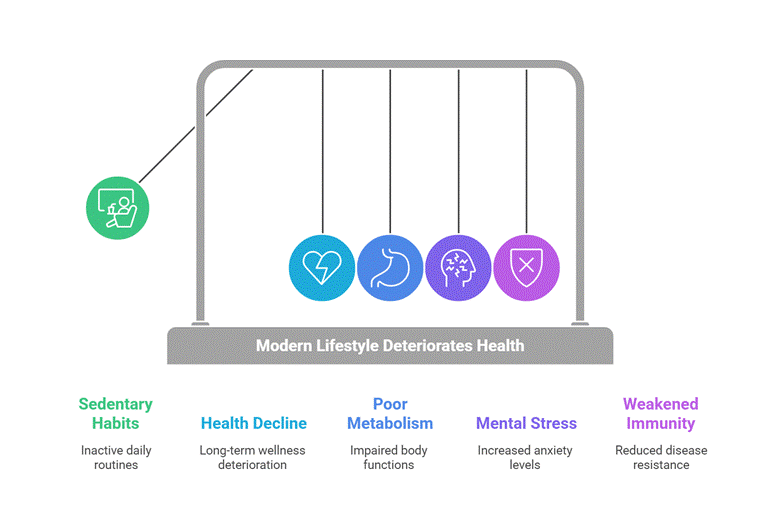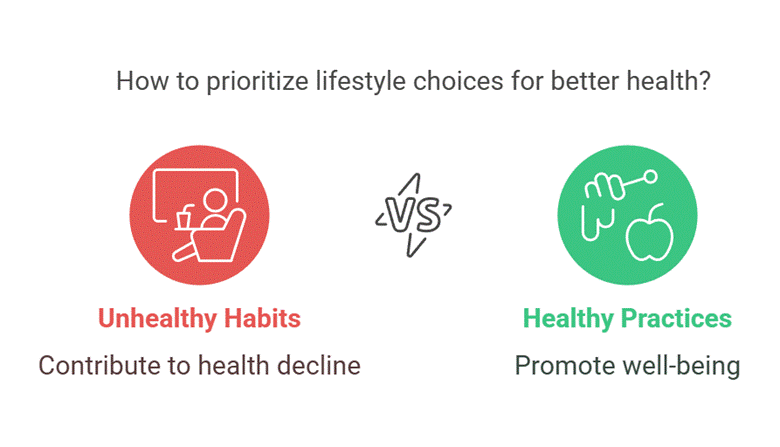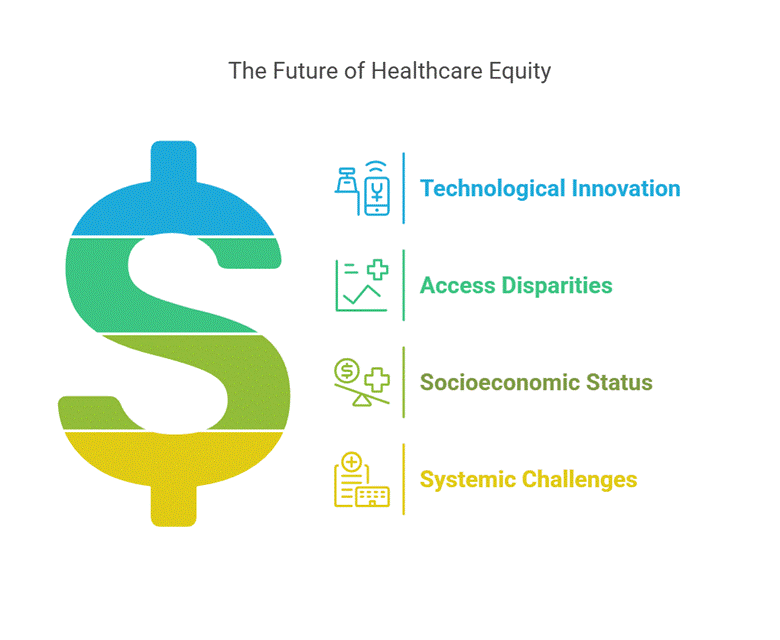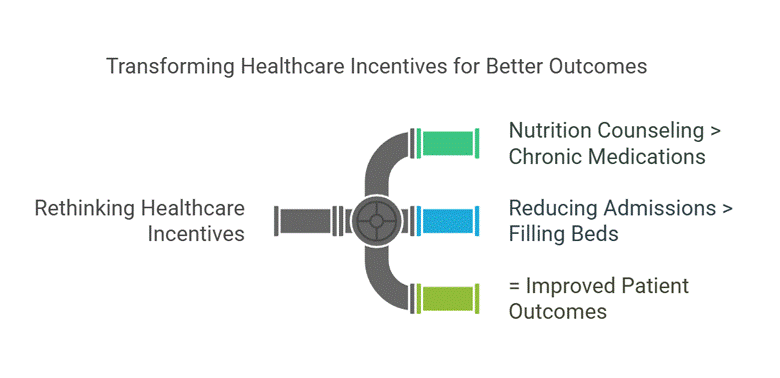The Medical Innovation Paradox – Why We’re Living Longer but Not Healthier
The Longevity Illusion – Are We Really Living Better?
Life expectancy has risen dramatically over the last century, with many developed nations surpassing an average lifespan of 80+ years. While people are living longer, chronic diseases such as diabetes, cardiovascular conditions, neurodegenerative disorders, and obesity-related illnesses are more prevalent than ever.
If medical science has achieved so much, why hasn’t this progress translated into healthier, higher-quality lives?
Modern Medical Innovation Breakthroughs
There’s no denying that modern medical breakthroughs are pushing the boundaries of what’s possible for future healthcare. On paper, it seems like we’ve cracked the code to better health. So why does the lived experience for so many people still tell a different story?
Biotechnology and personalized medicine have reshaped how we think about treatment. We can now analyze the full spectrum of genes, proteins, metabolites, and more, enabling hyper-personalized care. With AI now able to sift through enormous datasets, physicians can predict how an individual will respond to specific treatments and design interventions that are custom-tailored, not just based on general population averages.
Gene editing tools like CRISPR are showing promise in treating diseases once thought incurable. From inherited blood disorders like sickle cell disease to certain types of cancer, clinical trials are demonstrating what happens when we have the ability to edit our biological code at the source.
Artificial intelligence (AI) in healthcare is another game-changer. AI is now used to identify early signs of disease through medical imaging, predict patient outcomes, optimize treatment plans, and even assist in drug discovery. Algorithms can now flag a potential cancer diagnosis before a radiologist ever reviews the image. In some hospitals, AI systems are reducing diagnostic errors and helping overworked physicians manage patient care more efficiently.
And then there’s regenerative medicine, where scientists are exploring stem cell therapies, tissue engineering, and even 3D printing of organs. These innovations could offer hope for people with degenerative conditions, replacing damaged tissue instead of merely managing symptoms.
All of this has had a real impact. Cancer survival rates are improving in many parts of the world. Diseases like hepatitis C, once considered chronic and incurable, now have effective cures. AI models helped identify drug candidates and vaccine targets during the COVID-19 pandemic in record time. We’re seeing the early fruits of medical science’s potential to truly transform lives.
But—and it’s a big but—these innovations mostly extend lifespan, not necessarily healthspan. How is it that medicine is more advanced than ever, yet chronic illness is rising—and more people are spending longer periods of their lives in poor health?
Modern Health Crisis: Longer Lives ≠ Healthier Lives
This is our paradox: we’re living longer than ever before, yet we’re not necessarily living better. The average life expectancy in many countries has climbed past 80 years, but a growing number of those years are spent managing chronic disease, diminished mobility, and declining quality of life. It’s a strange and frustrating contradiction.
Let’s start with what’s behind this disconnect.
The Chronic Disease Epidemic
Despite our medical breakthroughs, chronic conditions like diabetes, heart disease, Alzheimer’s, autoimmune disorders, and obesity-related illnesses are surging globally. According to the World Health Organization, noncommunicable diseases now account for nearly three-quarters of all global deaths. In the U.S., nearly 60% of adults live with at least one chronic illness, and around 40% have two or more.
And most of these conditions are fueled by lifestyle and environmental factors rather than bad luck or genetic destiny.
The Lifestyle Factor
It seems obvious our daily habits are making us sick. Sedentary behavior, ultra-processed diets, chronic stress, sleep deprivation, and exposure to pollutants are all contributing to long-term health decline. While technology has advanced, our modern lifestyle has taken a toll on our metabolic health, mental resilience, and immune systems.

We’ve essentially built a society that makes it easier to get sick than to stay well.
Over-Medicalization vs. Prevention
The modern healthcare system tends to operate like a repair shop. We wait for problems to arise, then we patch them up with treatments and prescriptions. But this reactive approach has serious consequences. Instead of investing in preventive care, most healthcare systems are structured to reward ongoing treatment.
Here’s the hard truth: the business model of modern healthcare thrives on chronic illness. There’s more money to be made managing diabetes than preventing it. Pharmaceutical profits rely on repeat prescriptions, not cured patients. And while that may not be the intent of individual doctors or researchers, it’s often the reality of the system they work in.
Preventive measures like lifestyle coaching, nutrition education, and early intervention strategies are chronically underfunded. Insurance companies may cover expensive medications but balk at reimbursing for a visit to a dietitian. We’re pouring resources into treating disease after the fact, instead of addressing the root causes before they manifest.
So, even as science and technology race ahead, the foundations of health – movement, nutrition, connection, environment – are crumbling underneath us. And until we address that imbalance, we’ll continue to see longer lifespans filled with more years of illness.

Next up, we’ll explore the growing gap between cutting-edge science and basic healthcare needs, and why many people still struggle to access even the most fundamental care.
Cutting-Edge Science vs. Basic Healthcare Needs
It’s hard not to be amazed by the sophistication of modern medicine. We’re editing genes, printing organs, and using AI to detect disease before it even shows symptoms. But here’s the uncomfortable truth: many people still can’t access a doctor when they need one.
That’s the other side of the innovation paradox, while scientific advances grab headlines, basic healthcare remains out of reach for millions.
The Cost Barrier
Let’s start with the obvious: cutting-edge care is expensive. Whether it’s gene therapies that cost hundreds of thousands of dollars or personalized medicine that requires advanced diagnostics, the price tag of medical innovation often makes it inaccessible for all but the wealthiest patients or those in well-resourced systems.
Even in high-income countries, patients face skyrocketing out-of-pocket costs, insurance hurdles, and long wait times for specialized care. In low- and middle-income countries, these treatments are simply nonexistent, and in many places, so are the basics like antibiotics, vaccines, or clean medical facilities.
So while we talk about “the future of medicine,” too many people are still stuck in the past—struggling to get routine checkups, blood pressure medication, or prenatal care.
Healthcare Disparities: Innovation Doesn’t Mean Equity
The rise of AI-powered diagnostics is impressive, but what good is an AI model that can detect breast cancer with 95% accuracy if millions of women can’t get a mammogram in the first place?
Healthcare access remains deeply unequal. Rural populations, low-income communities, racial and ethnic minorities, and other underserved groups continue to experience worse health outcomes, not because technology isn’t available, but because systems aren’t built to reach them.
In this way, innovation risks widening the gap between those who can afford cutting-edge care and those who are left behind by a system that never prioritized them in the first place.
The uncomfortable question we need to ask is this: Are we creating a two-tier future of healthcare – one for the privileged few who benefit from innovation, and another for the rest who are left to navigate an underfunded, overstretched system?

If we want medical breakthroughs to truly matter, we need to do more than advance science, we need to bring that science to people in meaningful, accessible ways.
Next, we’ll look at how we can bridge the gap between medical brilliance and real-world well-being, and what it will take to shift from reactive medicine to preventive, inclusive care.
The Future of Healthcare – Bridging the Gap
If we want the next chapter of medical innovation to improve more than just statistics, we need to rethink what “healthcare” actually means. Extending life is no longer the gold standard, it’s improving the quality of those years that must become the real goal. That means shifting our systems, technologies, and incentives away from treating illness after it appears, and toward preventing it from happening in the first place.
From Reactive Care to Preventive Medicine
The future of healthcare won’t be found only in the lab, it will be shaped by how well we support people before they get sick. Prevention isn’t glamorous, but it’s powerful. We already know that lifestyle interventions like diet, exercise, sleep, stress management, and social connection are among the most effective “medicines” we have. Yet these interventions receive only a fraction of the attention (or funding) that high-tech therapies do.
Emerging fields like lifestyle medicine, functional medicine, and integrative health are working to change that narrative. Putting the whole person at the center of care, not just the disease. Studies in inflammation control, gut microbiome health, and longevity-focused nutrition are showing that addressing root causes can not only prevent illness but reverse early signs of chronic disease.
It’s not that we need less science. We need to apply it more wisely.
The Role of AI in Early Detection and Accessibility
AI’s potential goes far beyond drug discovery or robotic surgery. Its true impact may lie in early detection and accessibility.
AI-powered tools can now flag risks for cardiovascular disease, cancer, and diabetes years before symptoms appear. Wearables track subtle biometric shifts that help users understand their own health in real time. Algorithms can analyze electronic health records and genetics to recommend personalized lifestyle changes, before a crisis ever occurs.
Even more promising, AI has the potential to lower the cost of care. Remote diagnostics, virtual triage assistants, and smart health apps can deliver quality screening and support at scale. If we design these tools with equity and usability in mind, AI could become one of our best assets in closing care gaps.
Public Policy and Systemic Reform: Where Innovation Meets Access
Let’s be honest, technology alone won’t fix a broken healthcare system. Public policy, funding models, and corporate priorities need to shift in parallel. Governments and private sectors must begin to rethink incentives, rewarding prevention, health coaching, early intervention, and wellness programs instead of just surgeries and prescriptions.
Imagine a healthcare system where insurers provide better coverage for nutrition counseling than for chronic medications, or where hospitals are rewarded for reducing admissions, not filling more beds.

Healthcare innovators, policymakers, and business leaders must work together to build systems that value long-term well-being over short-term treatments. Until we align our technology with accessibility, prevention, and equity, we’ll continue to live in a world where our science outpaces our actual health.
Rethinking the Promise of Medical Progress
We live in an age where medical breakthroughs sound like science fiction. And yet, far too many people are spending their later years managing illness, not enjoying health. This is the paradox we can no longer ignore: we’re living longer, but we’re not living better.
So, what’s holding us back?
The real challenge ahead isn’t just to keep pushing the boundaries of science, it’s to ensure those advancements actually improve people’s lives. That means asking tougher questions:
- Can our systems prioritize prevention, not just treatment?
- Can we build healthcare models that value well-being, not just billing codes?
- Can we ensure innovation serves everyone, not just those who can afford it?
Yes, personal responsibility matters. Lifestyle, habits, and proactive care all play a role. But this isn’t just about individuals, it’s about rethinking the foundations of healthcare. It’s about building a world where longevity and healthspan rise together, not one at the expense of the other.
Because if medical innovation truly is revolutionary, then its success won’t be measured in years added to life, but in the life added to those years.
During World Health Month, SVIC is dedicated to exploring critical discussions on health, well-being, and medical innovation.
For all healthcare professionals and organisations out there, SVIC’s program Transforming the Healthcare Industry program offers an exclusive opportunity to explore the latest healthcare innovations, connect with industry pioneers, and gain actionable insights on leveraging technology for better patient outcomes.